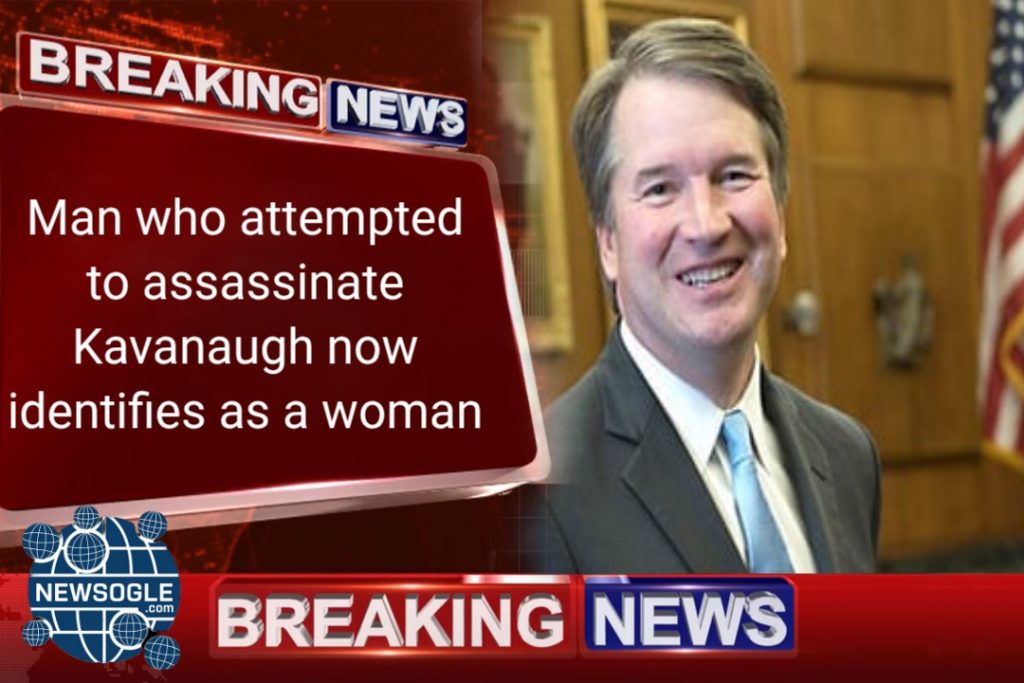
The already high-stakes and politically charged case against the individual who attempted to assassinate U.S. Supreme Court Justice Brett Kavanaugh has taken a new, complex turn. Court filings have revealed that Nicholas John Roske, the man arrested in 2022 outside of Kavanaugh’s home, now identifies as a woman and has requested to be referred to by the name Sophie and female pronouns. This development, surfacing just weeks before her scheduled sentencing, has introduced an unprecedented layer to a case that has already captured national attention and ignited a firestorm of debate over political violence, judicial security, and civil liberties.
The shocking revelation comes as Roske awaits sentencing after pleading guilty to a federal charge of attempting to murder a U.S. Supreme Court Justice. The potential sentence for this crime is severe, with federal guidelines suggesting a term of 30 years to life in prison. The transition in gender identity, while a personal and deeply significant matter for the individual, has been met with a range of reactions, from legal considerations to intense public scrutiny and political commentary. It has forced the legal system to grapple with evolving questions of identity and how they intersect with criminal proceedings, especially in cases of such national gravity.
Recounting the Assassination Plot: A Timeline of Intent
To understand the full weight of this new development, it is essential to revisit the events of June 8, 2022. In the early morning hours, Nicholas John Roske, then a 26-year-old from Simi Valley, California, arrived via taxi in the quiet neighborhood of Chevy Chase, Maryland, where Justice Kavanaugh resides. He was dressed in all black and was carrying a suitcase and a backpack filled with an arsenal of weapons and tools. The contents of his bags, as later revealed in court documents, painted a chilling picture of a premeditated plot: a Glock-17 pistol with two magazines and ammunition, a tactical knife, pepper spray, a hammer, a screwdriver, a nail punch, a crowbar, and duct tape.
Upon arriving at Kavanaugh’s home, Roske saw two U.S. Marshals stationed outside as part of the heightened security detail for the justices. This observation appears to have been a turning point. Roske, after a brief period of walking away, called 911. In a subsequent conversation with the police dispatcher, he confessed to having suicidal thoughts and stated his purpose for being there: “I came here from California to kill a specific United States Supreme Court justice.” He also revealed his motive, expressing anger over the recently leaked draft opinion in the Dobbs v. Jackson Women’s Health Organization case, which indicated the court was poised to overturn Roe v. Wade, as well as a concern over potential gun control rulings.
Roske’s intent went beyond a single act. Court documents and encrypted messages later revealed a more expansive plot. He had written about his goal to “stop roe v wade from being overturned” and to “remove some people from the Supreme Court.” In a particularly disturbing communication, he wrote, “I am shooting for 3,” indicating he planned to kill at least three conservative justices to fundamentally shift the balance of the court for “decades to come.” The FBI’s investigation uncovered that Roske had a list of at least two other conservative justices as potential targets. He had also conducted extensive online searches for the justices’ home addresses, as well as methods for breaking into homes and killing someone quietly.
The arrest came without violence, as Roske remained on the phone with the 911 dispatcher until officers arrived and took him into custody. He was subsequently charged with one count of attempting to murder a federal judge, and on April 8, 2025, he pleaded guilty to the charge, forgoing a trial.
The New Development: Identity and Legal Proceedings
In September 2025, as the legal process moved toward sentencing, the case took an unexpected turn with the defense’s notification that their client now identifies as a woman. The court filing requested that the defendant be referred to as Sophie Roske and be addressed using she/her pronouns in all future legal proceedings. This request is a significant factor in the context of a highly public and politically charged case, as it adds a layer of identity politics to an already volatile situation.
The legal system has increasingly had to navigate issues of gender identity and preferred pronouns. In many jurisdictions, it is standard practice for courts to respect an individual’s self-identified gender and use their requested name and pronouns. However, in a case as high-profile as this one, the move is subject to intense public and media scrutiny. For the prosecution and the judge, the primary concern remains the crime itself: a serious federal offense with life-altering implications for both the defendant and the intended victim. The legal proceedings will likely focus on the facts of the crime, the defendant’s state of mind at the time, and the appropriateness of the sentence, irrespective of their gender identity.
From a legal perspective, the defense’s request is likely a procedural step to ensure their client is treated with respect and to align the legal record with her current identity. The prosecution may choose to comply with the request as a matter of court decorum, or they may object, arguing that the change in identity is a distraction or is not legally relevant to the crime. Regardless, the judge will make the final determination on how the proceedings will move forward. The sentencing hearing, scheduled for October 3, 2025, will be a critical moment in this case, and it remains to be seen how the court will handle this new facet of the defendant’s identity.
Public Reaction: A Microcosm of National Division
The news has immediately become a topic of heated debate, reflecting the deep political and cultural divisions in the United States.
On the one hand, conservative commentators and political figures have criticized the move, with some suggesting it is a cynical attempt to gain sympathy or distract from the gravity of the crime. They argue that the focus should remain squarely on the fact that an attempt was made on the life of a Supreme Court Justice, and that the gender identity of the perpetrator is irrelevant. This viewpoint sees the action as part of a broader trend of “wokeness” and political correctness that they believe is encroaching upon the legal system. For them, the identity of the defendant does not change the nature of the crime and should not be a factor in sentencing.
On the other hand, supporters of transgender rights and some progressive commentators have argued that respecting the defendant’s gender identity is a matter of basic human dignity, regardless of the crime committed. They contend that a person’s identity is separate from their actions and that the court has a duty to use the correct name and pronouns. While not excusing the crime, they believe that the principle of respecting gender identity should be applied consistently, even in difficult and controversial cases. They may also point to the fact that the defendant had been undergoing treatment for an unspecified mental illness while in jail and that a gender transition can sometimes be part of a broader journey of self-discovery and mental health.
The differing reactions highlight how issues of gender identity have become a central part of the national discourse. The case of Sophie Roske, therefore, becomes not just a legal matter but a cultural touchstone, with each side using it to reinforce their own political and social narratives. The very act of reporting on the pronoun change has become a point of contention, with some media outlets using the requested pronouns and others continuing to use the name and pronouns assigned at birth, further illustrating the deep divide.
The Broader Context: Security and Political Violence
The attempted assassination of Justice Kavanaugh was a stark reminder of the increasing political polarization and the threat of violence against public officials. The leak of the draft Dobbs opinion in May 2022 led to widespread protests, some of which took place outside the homes of the Supreme Court justices. This prompted Congress to pass a bill expanding security protections for the justices and their families, a bipartisan move in a time of intense political gridlock.
The Roske case underscores that these security concerns were not unfounded. The FBI affidavit detailed how the individual’s plot was fueled by political anger over the Supreme Court’s potential decisions. Roske’s desire to “kill three” justices was an extreme manifestation of the political fury that has been building across the country. The case serves as a powerful symbol of the dangers of escalating rhetoric and the normalization of political violence.
In this context, the new development regarding Roske’s gender identity adds another layer to an already complicated story. It raises questions about how the media and the public should discuss individuals who commit politically motivated crimes, especially when those individuals are part of a marginalized community. It forces a conversation about whether identity should be a factor in public discourse about a crime and how to balance respect for a person’s identity with the need to hold them accountable for their actions.
Conclusion: The Path Forward
The case of Sophie Roske is a microcosm of the United States in the 2020s: a nation grappling with political extremism, mental health crises, and rapidly changing social norms. As the case moves toward sentencing, the court will have the challenging task of navigating a legal framework designed for an earlier era while contending with the complexities of modern identity. The sentence handed down will not only decide the fate of one individual but may also send a powerful message about the seriousness of politically motivated violence and the principles of justice in a polarized society. For now, the case remains a flashpoint, a stark reminder that even in the quietest of neighborhoods, the ideological battles of the nation can manifest in dangerous ways.
The news report offers more details on the federal charges filed against the individual involved in the attempted assassination.
California man faces federal charges for attempted murder of Justice Brett Kavanaugh





